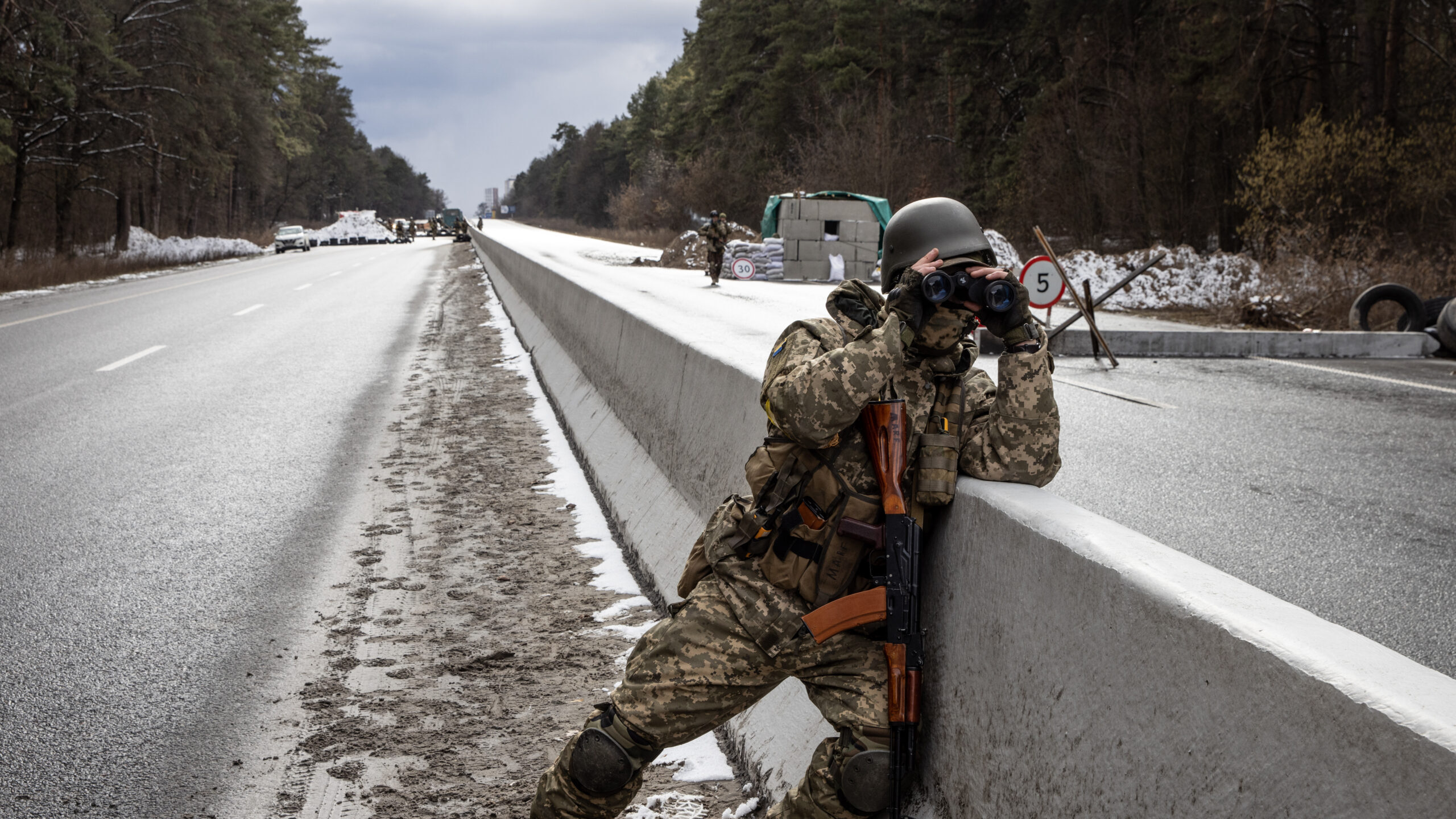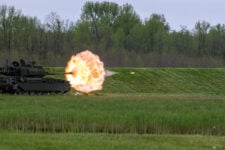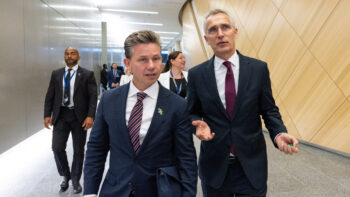
A member of the Ukrainian military uses binoculars at a forward position on the eastern frontline near Kalynivka village as Russian forces advanced on March 08, 2022, in Kyiv, Ukraine. (Photo by Chris McGrath/Getty Images)
As the Russian invasion of Ukraine approached, the US did something unusual with hard-won, highly classified secrets: it shared them, both with allies and the public. In the below op-ed Joshua Huminski of the Mike Rogers Center for Intelligence & Global Affairs explains how the strategy worked, some dangers that come along with it, and how it could shape intelligence and policy in the future.
The United States’ efforts to persuade its allies of a pending Russian invasion of Ukraine, and to rob Russia of any legitimacy in going through with it, marked a notable shift in the use of strategic intelligence — one that could signal a new era for intelligence-as-strategy, and one for which Beijing, among others, is likely preparing.
New details divulged in a recent, expansive Washington Post piece highlighted the efforts Washington undertook — and the challenges it encountered — to convince allies in Europe and Ukraine of the imminence of the threat from Russia. The campaign was characterized by the aggressive and forward-leaning use of sanitized intelligence, carefully but repeatedly revealing not only Russian troop movements but purported intelligence from inside Russian military and political circles, including how, exactly, Russia planned to use a false flag operation to justify the invasion.
Beyond preparing the ground for the international response to Russia’s invasion and effectively neutering any justification for it, by selectively disclosing Russian intentions, the US was showing to its allies and to Moscow that it had deep insights into the inner workings of the Kremlin and, at the same time, had achieved a significant penetration either by human or electronic means (or both). In communicating this to allies and adversaries alike, even done in a way that obfuscated the source of the information, it demonstrated that it was willing to risk of jeopardizing sources and methods to achieve political ends.
This is, of course, not the first time that the United States has used strategic intelligence to achieve a policy outcome on the international stage. For example, in 1961, the United States disclosed aerial surveillance photos of the Soviet Union’s deployment of medium range ballistic missiles on Cuba before the United Nations Security Council. Just over 40 years later, then Secretary of State Colin Powell presented a detailed brief on alleged, and inaccurate, intelligence related to Iraq’s weapons of mass destruction program. This, then, is not revolutionary in and of itself.
What is novel about the case in Ukraine is the level of detail and frequency with which this information was reportedly shared, including public revelations, and the extent to which presumably high-level intelligence was sanitized for both the public and nation-state consumption on a near daily, if not hourly, basis.
This is intelligence less as an element in policymaking and more of intelligence as an effect in and of itself – almost on the tactical level – that takes aim at a breadth of targets, from the adversary, to allies, to non-aligned states, and states leaning toward one or the other. Whereas in the past, intelligence was used to inform policymakers, here intelligence was being used to shape—in a very public way—strategic effects.
The information itself was of paramount importance to Ukraine and European allies, but so to was the signal that it sent to Russia: Clearly the United States and its allies had eyes and ears inside the Kremlin’s decision-making apparatus and very near to President Vladimir Putin.
There is, of course, a critical balance to be struck in any intelligence operation between the protection of sources and methods and the utility of the information in question to policymakers. Indeed, it is relatively uncommon for such high-quality information to directly make it into the public domain, or make it into the public domain where sources and methods could, in theory, be inferred at a very macro-level. Yet, this is effectively what the United States and United Kingdom did, and to some degree continues to do today.
This is not to say that sources and methods do not matter—far from it; the protection of those remains a critical priority. No high-profile media reports, including the Post piece, have revealed what, if any, intelligence advantage the West may have surrendered in the process, though speculation abounds as to whether it was human or signals intelligence, or both. But the public strategy suggests that the public use of intelligence, at least in the case of Ukraine, was deemed by policymakers to be of greater and more pressing importance.
This is unsurprising as there was a land war in Europe looming, though it does not automatically suggest the same will be the case in the future. It stands to reason that if, for example, the United States had similar sources in Beijing and feared an imminent invasion of Taiwan, strategic intelligence could be sanitized as necessary and used in a much broader and public strategic signaling manner than in years past.
With this kind of gambit, however, there is also another risk to consider: What happens when intelligence goes beyond merely informing policymaking, but is used in a more direct manner to support politics and policymaking? The politicization of intelligence risks undermining the ostensible impartiality of the content or information being presented. This is not without precedent as in the case of the run-up to the Iraq war. Equally, what happens when the political desire to send a strategic message via intelligence requires the risking of sources or methods? Does a near-term political priority of messaging outweigh the benefits of long-term penetration or access? In the 240-character nature of modern crises, that is a question that will likely be revisited in the future.
So many months after the invasion, undoubtedly both Russia and China have taken notes from America’s use of intelligence, and from the effectiveness of Moscow’s own response. Whereas Washington and London are conducting very overt strategic communications efforts, buttressed by the selective use of sanitized intelligence, Moscow is flooding the same information space with a deluge of content and messaging. Here the goal is not so much the persuasion of its allies or the non-aligned states, so much as undermining the West’s narratives and introducing doubt into communities in the Global South.
These messages leverage pre-existing notions of Western imperialism and doubts about the West’s intentions. Indeed, the response to Russia’s invasion of Ukraine is less global than Western and Northern European. With the sheer quantity of messages, the quality of which is often wanting, it is a numbers game for Moscow—it only takes one message to make it through and either reaffirm an existing position, or change a target’s perspective or behavior. While Russia would almost certainly prefer to have these non-aligned states on its side, it will likely be satisfied with crafting a narrative that keeps these states disengaged.
China’s lessons on the use of intelligence-as-strategy, one suspects, are a function of its broader lessons from Russia’s performance in Ukraine, and the steps prior to the opening gambit. Beijing may well adopt a more patient and longer-term perspective on the use of intelligence for strategic effects, but it may not be necessary at all. In the case of a Taiwan crisis, Beijing may not seek to either saturate the information space as Russia is, or selectively use intelligence to make its case as Washington did ahead of the invasion of Ukraine.
Rather, as the almost certain aggressor, it will seek to obviate the need for strategic intelligence or strategic communication by achieving a fait accompli on the ground. There is little expectation that China will be able to sufficiently massage its efforts, its intelligence, or its strategic communications to justify its invasion to an international community, in the event it is the aggressor.
Rather, it is more likely to use its energies to define the scope and parameters of conflict e.g. publicly define its red-lines with the United States. At the same time, it will undoubtedly work to leverage “intelligence” and strategic communications more for a domestic audience.
As with many elements of Russia’s war in Ukraine, the lessons that Russia and China will draw remain unclear and are only just emerging. And it is wholly possible that the lessons drawn now will not be the lessons leveraged in the future. Equally too, it is unclear how the Intelligence Community’s role and effort to communicate the threat will affect the future use of strategic intelligence. While it may not have been an immediate success in convincing ally and adversary alike, the Intelligence Community’s performance in Ukraine is a demonstrable success. Yet, it is clear that the future use of strategic intelligence will be far broader in scope, and faster in practice, than in the past.
Joshua C. Huminski is the Director of the Mike Rogers Center for Intelligence & Global Affairs at the Center for the Study of the Presidency & Congress. There he co-chairs the Center’s program on strategic competition, with a specific focus on Russia. He is a Fellow at George Mason University’s National Security Institute. He can be found on Twitter at @joshuachuminski.
HASC adds Virginia-class sub, cuts F-35s in $849.8 billion draft defense policy bill
The bill sticks to budget caps laid out by the Fiscal Responsibility Act.


























